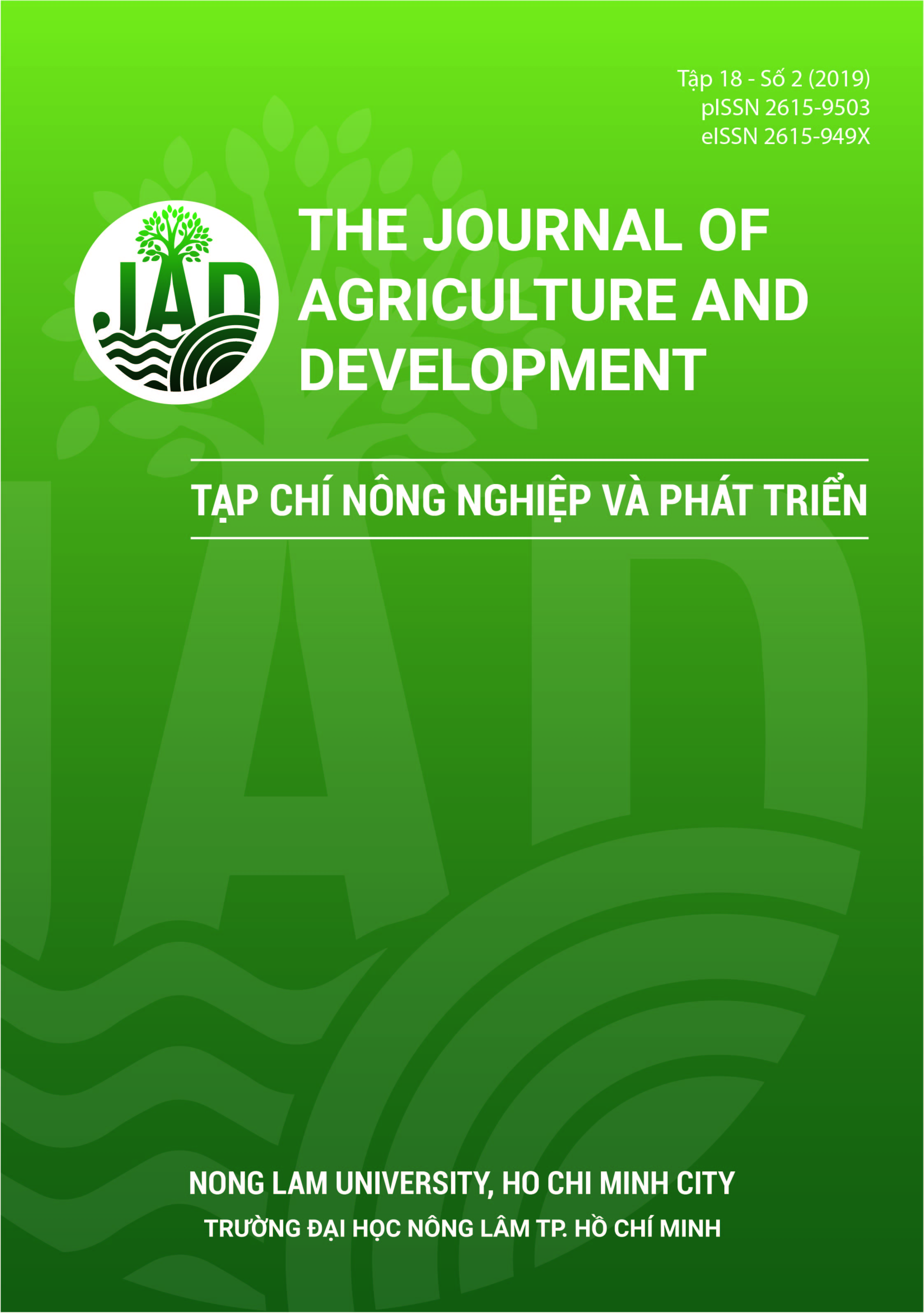Ảnh hưởng của điều kiện ngâm và ủ đến hàm lượng gamma - aminobutyric acid và polyphenol trong hạt đậu xanh nẩy mầm
Main Article Content
Tóm tắt
Hạt đậu xanh nẩy mầm được biết đến như nguồn thực phẩm giàu các hợp chất sinh học như gamma aminobutyric acid và polyphenol. Nghiên cứu này thực hiện nhằm đánh giá tác động của điều kiện ngâm và ủ đến hàm lượng gamma - aminobutyric acid (GABA) và polyphenol trong mầm hạt đậu xanh. Kết quả đạt được điều kiện ngâm hạt ở 300C trong vòng 8 giờ cho hàm lượng GABA cao nhất (4,51 mg/g). Trong khi đó, hàm lượng polyphenol tổng cao nhất (1,25 mg GAE/g) đạt được khi ngâm ở 350C trong 8 giờ. Điều kiện ủ hạt ở 350C trong vòng 24 giờ cho thấy hàm lượng GABA và polyphenol đều đạt giá trị cao nhất, lần lượt tương ứng với 4,46 mg/g và 1,30 mg GAE/g.
Article Details
Tài liệu tham khảo
Ajila, C. M., Brar, S. K., Verma, M., Tyagi, R. D., Godbout. S., & Valéro, J. R. (2011). Extraction and analysis of polyphenols: Recent trends. Critical Reviews in Biotechnology 31(3), 227-249. https://doi.org/10.3109/07388551.2010.513677
Akillioglu, H. G., & Karakaya, S. (2010). Changes in total phenols, total flavonoids, and antioxidant activities of common beans and pinto beans after soaking, cooking, and in vitro digestion process. Food Science and Biotechnology 19(3), 633-639. https://doi.org/10.1007/s10068-010-0089-8
Banchuen, J., Thammarutwasik, P., & Ooraikul, B. (2009). Effect of germinating processes on bioactive component of Sangyod Muang Phatthalung rice. Thai Journal of Agricultural Science 42(4), 191-199.
Chung, H. J., Jang, H.C., Cho, H. Y., & Lim, S. T. (2009). Effects of steeping and anaerobic treatment on GABA (γ-aminobutyric acid) content in germinated waxy hull-less barley. LWT - Food Science and Technology 42(10), 1712-1716. https://doi.org/10.1016/j.lwt.2009.04.007
El-Adawy, T. A., Rahma, E. H., El-Bedawey, A. A., & ElBeltagy, A. E. (2003). Nutritional potential and functional properties of germinated mung bean, pea and lentil seeds. Plant Foods for Human Nutrition 58(3), 1-13. https://doi.org/10.1023/B:QUAL.0000040339.48521.75
Fernandez-Orozco, R., Frias, J., Zielinski, H., Piskula, M. K., Kozlowska, H., & Vidal-Valverde, C. (2008). Kinetic study of the antioxidant compounds and antioxidant capacity during germination of Vigna radiata cv. emmerald, Glycine max cv. jutro and Glycine max cv. merit. Food Chemistry 111(3), 622-630. https://doi.org/10.1016/j.foodchem.2008.04.028
Guo, Y., Chen, H., Song, Y., & Gu, Z. (2011). Effects of soaking and aeration treatment on γ-aminobutyric acid accumulation in germinated soybean (Glycine max L.). European Food Research and Technology 232(5), 787-795. https://doi.org/10.1007/s00217-011-1444-6
Huang, X., Cai, W., & Xu, B. (2014). Kinetic changes of nutrients and antioxidant capacities of germinated soybean (Glycine max l.) and mung bean (Vigna radiata l.) with germination time. Food Chemistry 143, 268-276. https://doi.org/10.1016/j.foodchem.2013.07.080
Hussain, I., & Uddin, M. B. (2012). Optimization of germination conditions for germinated wheat flour by response surface methodology. African Journal of Food Science and Technology 3(1), 16-22.
Kanatt, S. R., Arjun, K., & Sharma, A. (2011). Antioxidant and antimicrobial activity of legume hulls. Food Research International 44(10), 3182-3187. https://doi.org/10.1016/j.foodres.2011.08.022
Karladee, D., & Suriyong, S. (2012). γ-Aminobutyric acid (GABA) content in different varieties of brown rice during germination. Science Asia 38(1), 13-17. https://doi.org/10.2306/scienceasia1513-1874.2012.38.013
Kitaoka, S., & Nakano, Y. (1969). Colorimetric determination of w-amino acids. The Journal of Biochemistry 66(1), 87-94. https://doi.org/10.1093/oxfordjournals.jbchem.a129124
Komatsuzaki, N., Tsukahara, K., Toyoshima, H., Suzuki, T., Shimizu, N., & Kimura, T. (2007). Effect of soaking and gaseous treatment on GABA content in germinated brown rice. Journal of Food Engineering 78(2), 556-560. https://doi.org/10.1016/j.jfoodeng.2005.10.036
Paucar-Menacho, L. M., Pen˜as, E., Duen˜as, M., Frias, J., & Martínez-Villaluenga, C. (2017). Optimizing germination conditions to enhance the accumulation of bioactive compounds and the antioxidant activity of kiwicha (Amaranthus caudatus) using response surface methodology. LWT - Food Science and Technology 76B, 245-252. https://doi.org/10.1016/j.lwt.2016.07.038
Randhir, R., Lin, Y. T., & Shetty, K. (2004). Stimulation of phenolics, antioxidant and antimicrobial activites in dark germinated mung bean sprouts in response to peptide and phytochemical elicitors. Process Biochemistry 39(3), 637-646. https://doi.org/10.1016/S0032-9592(03)00197-3
Song, H. Y., & Yu, R. C. (2018). Optimization of culture conditions for gamma-aminobutyric acid production in fermented adzuki bean milk. Journal of Food and Drug Analysis 26(1), 74-81. https://doi.org/10.1016/j.jfda.2016.11.024
Tiansawang, K., Luangpituksa, P., Varanyanond, W., & Hansawasdi, C. (2016). GABA (γ-aminobutyric acid) production, antioxidant activity in some germinated dietary seeds and the effect of cooking on their GABA content. Food Science and Technology 36(2), 313-321. https://doi.org/10.1590/1678-457X.0080
Watchararparpaiboon, W., Laohakunjit, N., & Kerdchoechuen, O. (2010). An improved process for high quality and nutrition of brown rice production. Food Science and Technology International 16(2), 147-158. https://doi.org/10.1177/1082013209353220
Wongsiri, S., Ohshima, T., & Duangmal, K. (2015). Chemical composition, amino acid profile and antioxidant activities of germinated mung beans (Vigna radiata). Journal of Food Processing and Preservation 39(6), 1956-1964. https://doi.org/10.1111/jfpp.12434
Z lotek, U., Mikulska, S., Nagajek, M., & Swieca, M.´ (2016). The effect of different solvents and number of extraction steps on the polyphenol content and antioxidant capacity of basil leaves (Ocimum basilicum L.) extracts. Saudi Journal of Biological Sciences 23(5), 628-633. https://doi.org/10.1016/j.sjbs.2015.08.002








